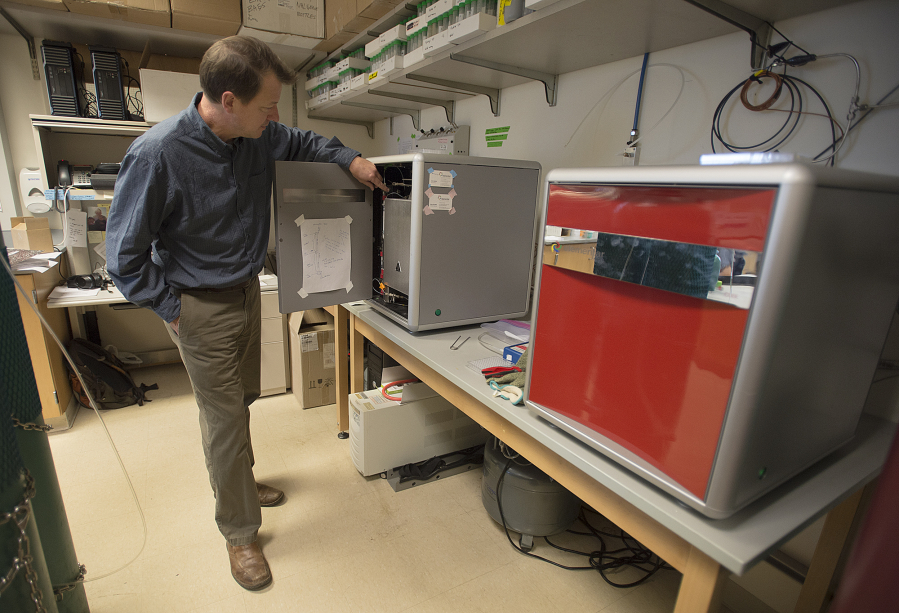Deep-rooted plants may be key to removing carbon dioxide from the atmosphere if land managers can capitalize on a new scientific finding from Marc Kramer, an assistant professor at Washington State University Vancouver, and his associates.
Kramer, who teaches environmental chemistry, and a group of scientific colleagues found a vast pool of old carbon lurking a foot or more beneath the Earth’s surface. The discovery of the carbon, which likely was deposited from deep-rooted plants pulling it out of the atmosphere over time, could point to a way to use agriculture to remove even more carbon dioxide from the air and lessen the impacts of global climate change.
“There’s a lot of gloom and doom about climate change, and here we have something that could turn into a win-win,” Kramer said. “Very few studies have looked this far deep. Most studies have focused on topsoil.”
Among Kramer’s findings was that Earth’s soils hold about three times the carbon currently in the atmosphere, an amount much larger than was previously thought.
“It’s a very large pool, and the estimates keep getting bigger,” Kramer said. “We used to think it was just twice as much (as the carbon in the atmosphere) a decade ago, and we thought it was even smaller before that.”
He added that the amount more than a foot below the surface is about 1.5 times that found in the atmosphere.
The pool indicates Earth has a way of getting carbon out of the atmosphere and stashing it away. That method is known as carbon sequestration. If humans can harness that technique, they may be able to make a dent in rapid global climate change, he said.
“We really need to get serious about the science of farming, and incorporating that with radical farming ideas,” Kramer said, adding that encouraging farmers to alter their practices while also giving them carbon tax credits could be a big win for everybody. “It’s novel, profitable and sustainable.”
Focus on agriculture
Kramer, working with researchers from Stanford University, Oregon State University and other institutions, recently released his findings in two journals, the Annual Review of Ecology, Evolution and Systematics, and Biogeochemistry Letters.
Agriculture is a key area of focus because it plays a large role in the ability of plants to pull carbon out of the air and into the subsoil. Almost three-fourths of all carbon trapped in the top three feet of soil is affected by farming, grazing and forest management practices, Kramer said.
“One real important dimension of this is most human activity in the future will be in repurposing existing farm lands, and that creates new opportunity,” Kramer said.
The discovery of the carbon in the lower soil layers also indicates poor land use practices are likely contributing to global climate change, something that’s detailed in the Annual Review of Ecology paper, of which Robert Jackson, an earth sciences professor at Stanford, was the lead author.
“(Soil organic matter in the top foot of soil) is also decomposed by microbes, returning CO2, a greenhouse gas, to the atmosphere,” the scientists said in the abstract. “Unfortunately, soil carbon stocks have been widely lost or degraded through land use changes and unsustainable forest and agricultural practices.”
Kramer said a dairy ranching method he examined could help counter that. The method, used by a New Zealand dairy farmer, separated what had been poor grazing land into about 30 paddocks. The farmer planted Bermudagrass to replenish the soil, and then rotated the cows through one new paddock each day for a month, repeating the cycle each month.
The method brought the topsoil, which had been extremely depleted from constant animal use, back to pre-industrial nutrient rates within a few years, and the practice also allowed more root systems to grow and for plants to pull more carbon out of the atmosphere, he said.
“We have opportunity to do that here,” Kramer said of Clark County.
Stashing the carbon
Using farms and other land to sequester carbon would increase the planet’s ability to remove carbon from the air. The efforts don’t have to be huge, Kramer said.
“We don’t need to double or triple the amount that we’re doing that, even a slight percentage increase could offset CO2 emissions significantly,” Kramer said.
A concern with carbon stored in the subsoil is that a meteor impact or construction project could disturb and release it into the atmosphere. But carbon a foot below the surface chemically bonds more strongly to its surroundings than it does in topsoil where it’s broken down by water, insects and animal activity, so that risk is minimal, Kramer said.
“It’s not as scary as it looks actually,” Kramer said. “The carbon in the soil is connected by strong chemical bonds. It’s been there for a long time, and it’s likely to stick around for a while.”
Now that the findings are out, he hopes more scientists and land managers will consider new possibilities for using the lower soil layers as a carbon sink.
“I don’t think this one land practice is all we have,” Kramer said. “To me it raises a bigger question of what else is possible.”



